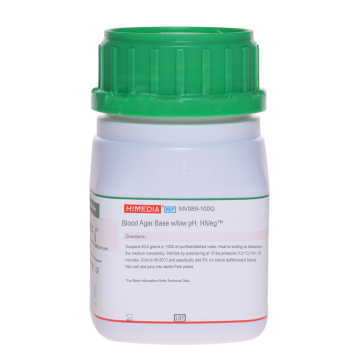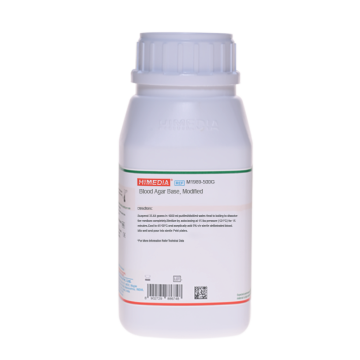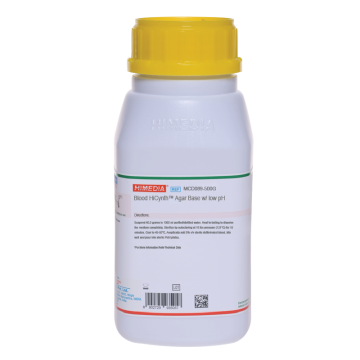 Your enquiry has been submitted
Your enquiry has been submitted
Blood Agar Base w/ low pH
Intended use
Recommended as a base to which blood may be added for use in the isolation and cultivation of fastidious pathogenic microorganisms like Neisseria, Streptococci etc from clinical samples.
Composition**
| Ingredients | g/L |
|---|---|
| HM infusion B from 500g # | 10.000 |
| Tryptose | 10.000 |
| Sodium chloride | 5.000 |
| Agar | 15.000 |
Final pH (at 25°C): 6.8±0.2
**Formula adjusted, standardized to suit performance parameters
#.- Equivalent to Beef heart, infusion from
Directions
Suspend 40.00 grams in 1000 ml purified/distilled water. Heat to boiling to dissolve the medium completely. Sterilize by autoclaving at 15 lbs pressure (121°C) for 15 minutes. Cool to 45-50°C and aseptically add 5% v/v sterile defibrinated blood. Mix well and pour into sterile Petri plates.
Principle And Interpretation
Blood Agar Base is a highly nutritious medium generally used as a basal medium for preparing blood agar by supplementation with blood. It can also be used as general-purpose media without the addition of blood. If the culture medium is to be used without addition of blood, the pH should be adjusted to 7.2 to 7.4, since most bacteria can grow better in a slightly alkaline medium. The low pH of Blood Agar Base w/ low pH (pH 6.8) stabilizes the red blood corpuscles and favors the formation of clear zone of haemolysis (1). Also it is advantageous for cultivation of Streptococci and Pneumococci Blood Agar Base media can be used with added phenolphthalein phosphate (2) for the detection of phosphate producing staphylococci, with added salt and agar for assessment of surface contamination on equipment and pig carcass (3) and to determine salinity range of marine Flavobacteria (4). It can also be used for preparation of Salmonella Typhi antigens (5).
HM infusion B from and tryptose provides carbon, nitrogen, amino acids and vitamins. Sodium chloride helps in maintaining the osmotic equilibrium of the medium. Addition of blood makes the medium more nutritious by providing additional growth factors required by fastidious organisms. It also helps in visualizing the haemolytic reactions. However, haemolytic reactions depend on the animal blood used. Sheep blood gives best results for Group A Streptococci (6). But sheep blood fails to support growth of Haemophilus haemolyticus since sheep blood is deficient in pyridine nucleotides. However when horse blood is used H. haemolyticus colonies produce haemolysis and mimic Streptococcus pyogenes (7).
Type of specimen
Clinical material : faeces, pus, sputum
Specimen Collection and Handling
For clinical samples follow appropriate techniques for handling specimens as per established guidelines (8,9).
After use, contaminated materials must be sterilized by autoclaving before discarding.
Warning and Precautions
In Vitro diagnostic use. For professional use only. Read the label before opening the container. Wear protective gloves/ protective clothing/eye protection/ face protection. Follow good microbiological lab practices while handling specimens and culture. Standard precautions as per established guidelines should be followed while handling clinical specimens. Safety guidelines may be referred in individual safety data sheets.
Limitations
- Addition of sheep blood is recommended to detect haemolysis. This medium does not support the growth of H.haemolyticus.
- Addition of Horse blood or rabbit blood to base medium supports growth of H.haemolyticus but resemble beta-haemolytic Streptococci and hence must be confirmed.
- Haemolytic pattern varies with the source of blood used.
- Further biochemical and serological tests must be performed for confirmation.
Performance and Evaluation
Performance of the medium is expected when used as per the direction on the label within the expiry period when stored at recommended temperature.
Quality Control
Appearance Cream to yellow homogeneous free flowing powder
Gelling Firm, comparable with 1.5% Agar gel
Colour and Clarity of prepared medium Basal medium: Light amber coloured clear to slightly opalescent gel. After addition of 5-7% v/v sterile defibrinated blood : Cherry red coloured opaque gel forms in Petri plates.
Reaction Reaction of 4.0% w/v aqueous solution at 25°C. pH : 6.8±0.2
pH 6.60-7.00
Cultural Response Cultural characteristics observed with added 5% v/v sterile defibrinated blood, after an incubation at 35-37°C for 18-48 hours.
| Organism | Inoculum (CFU) | Growth (w/o blood) | Recovery (w/o blood) | Growth (with blood) | Recovery (with blood) | Haemolysis |
|---|---|---|---|---|---|---|
| Neisseria meningitidis ATCC 13090 | 50-100 | fair-good | 40-50% | luxuriant | >=70% | none |
| Staphylococcus aureus subsp. aureus ATCC 25923 (00034*) | 50-100 | good | 50-70% | luxuriant | >=70% | beta |
| Staphylococcus epidermidis ATCC 12228 (00036*) | 50-100 | good | 50-70% | luxuriant | >=70% | none |
| Streptococcus pneumoniae ATCC 6303 | 50-100 | fair-good | 40-50% | luxuriant | >=70% | alpha |
| Streptococcus pyogenes ATCC 19615 | 50-100 | fair-good | 40-50% | luxuriant | >=70% | beta |
Key: * - Corresponding WDCM numbers
Storage and Shelf Life
Store between 10-30°C in tightly closed container and the prepared medium at 2-8°C. Use before expiry date on the label. On opening, product should be properly stored dry, after tightly capping the bottle in order to prevent lump formation due to the hygroscopic nature of the product. Improper storage of the product may lead to lump formation. Store in dry ventilated area protected from extremes of temperature and sources of ignition Seal the container tightly after use. Product performance is best if used within stated expiry period.
Disposal
User must ensure safe disposal by autoclaving and/or incineration of used or unusable preparations of this product. Follow established laboratory procedures in disposing of infectious materials and material that comes into contact with clinical sample must be decontaminated and disposed of in accordance with current laboratory techniques (8,9).
Reference
- Norton J. F., 1932, J. Lab. Clin. Med., 17:558-565.
- Noble W. C., 1962, J. Clin, Pathol., 15:552.
- Hansen N. H., 1962, J. Appl. Bacteriol., 25:46.
- Hayes P. R., 1963, J. Gen. Microbiol., 30:1.
- Schuber J. H., Edwards P. R. and Ramsere C. H., 1959, J. Bacteriol., 77:648.
- Snavely J. G. and Brahier J., 1960, Am. J. Clin. Pathol., 33:511.
- Murray P. R., Baron J. H., Jorgensen J. H., Pfaller M. A., Yolken R. H., (Eds.), 8th Ed., 2003, Manual of Clinical
- Isenberg, H.D. Clinical Microbiology Procedures Handbook. 2nd Edition.
- Jorgensen, J.H., Pfaller, M.A., Carroll, K.C., Funke, G., Landry, M.L., Richter, S.S and Warnock., W.(2015) Manual of Clinical Microbiology, 11th Edition. Vol. 1.
| Product Name | Blood Agar Base w/ low pH |
|---|---|
| SKU | M089 |
| Product Type | Regular |
| Physical Form | Powder |
| Origin | Animal |
| Packaging type | HDPE |
| References | 1. Norton J. F., 1932, J. Lab. Clin. Med., 17:558-565. 2.Noble W. C., 1962, J. Clin, Pathol., 15:552. 3.Hansen N. H., 1962, J. Appl. Bacteriol., 25:46. 4.Hayes P. R., 1963, J. Gen. Microbiol., 30:1. 5.Schuber J. H., Edwards P. R. and Ramsere C. H., 1959, J. Bacteriol., 77:648. 6.Snavely J. G. and Brahier J., 1960, Am. J. Clin. Pathol., 33:5 7.Murray P. R., Baron J. H., Jorgensen J. H., Pfaller M. A., Yolken R. H., (Eds.), 8th Ed., 2003, Manual of ClinicalMicrobiology, ASM, Washington, D.C. 8.Isenberg, H.D. Clinical Microbiology Procedures Handb0ook. 2nd Edition. 9.Jorgensen,J.H., Pfaller , M.A., Carroll, K.C., Funke, G., Landry, M.L., Richter, S.S and Warnock., D.W. (2015)Manual of Clinical Microbiology, 11th Edition. Vol. 1. |
| Customized Product Available | No |







